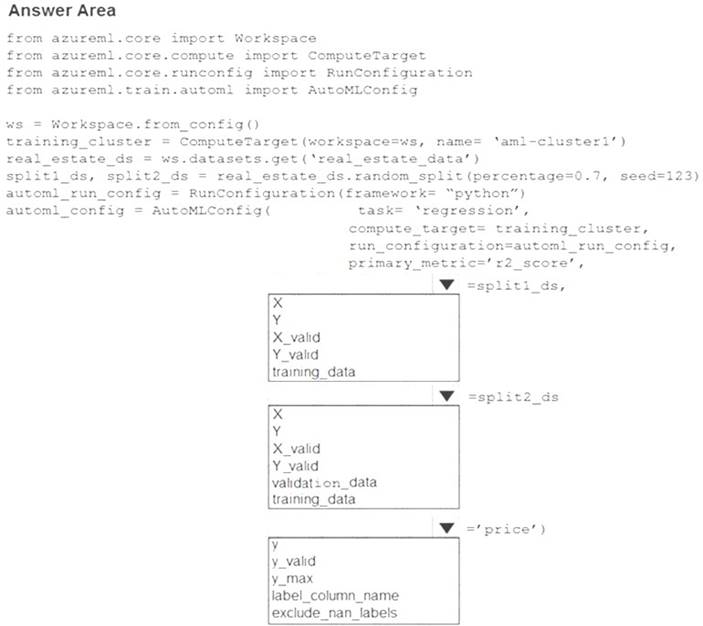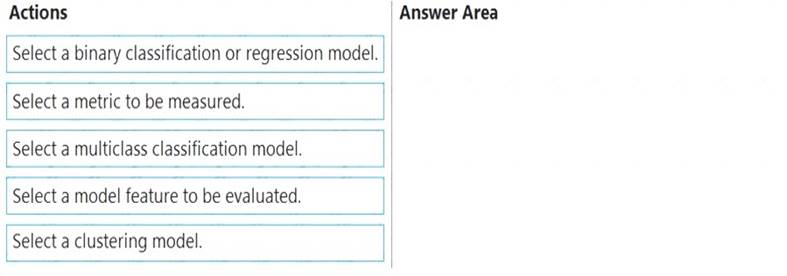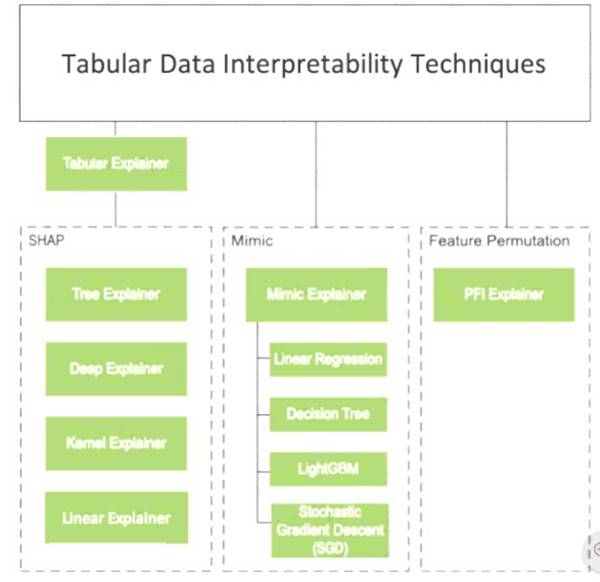- (Exam Topic 3)
Your Azure Machine Learning workspace has a dataset named real_estate_data. A sample of the data in the dataset follows.
You want to use automated machine learning to find the best regression model for predicting the price column. You need to configure an automated machine learning experiment using the Azure Machine Learning SDK. How should you complete the code? To answer, select the appropriate options in the answer area.
NOTE: Each correct selection is worth one point.
Solution:
Box 1: training_data
The training data to be used within the experiment. It should contain both training features and a label column (optionally a sample weights column). If training_data is specified, then the label_column_name parameter must also be specified.
Box 2: validation_data
Provide validation data: In this case, you can either start with a single data file and split it into training and validation sets or you can provide a separate data file for the validation set. Either way, the validation_data parameter in your AutoMLConfig object assigns which data to use as your validation set.
Example, the following code example explicitly defines which portion of the provided data in dataset to use for training and validation.
dataset = Dataset.Tabular.from_delimited_files(data)
training_data, validation_data = dataset.random_split(percentage=0.8, seed=1) automl_config = AutoMLConfig(compute_target = aml_remote_compute, task = 'classification',
primary_metric = 'AUC_weighted', training_data = training_data,
validation_data = validation_data, label_column_name = 'Class'
)
Box 3: label_column_name label_column_name:
The name of the label column. If the input data is from a pandas.DataFrame which doesn't have column names, column indices can be used instead, expressed as integers.
This parameter is applicable to training_data and validation_data parameters. Reference:
https://docs.microsoft.com/en-us/python/api/azureml-train-automl-client/azureml.train.automl.automlconfig.auto
Does this meet the goal?
Correct Answer:
A
- (Exam Topic 3)
Note: This question is part of a series of questions that present the same scenario. Each question in the series contains a unique solution that might meet the stated goals. Some question sets might have more than one correct solution, while others might not have a correct solution.
After you answer a question in this section, you will NOT be able to return to it. As a result, these questions will not appear in the review screen.
You have a Python script named train.py in a local folder named scripts. The script trains a regression model by using scikit-learn. The script includes code to load a training data file which is also located in the scripts folder.
You must run the script as an Azure ML experiment on a compute cluster named aml-compute.
You need to configure the run to ensure that the environment includes the required packages for model training. You have instantiated a variable named aml-compute that references the target compute cluster.
Solution: Run the following code:
Does the solution meet the goal?
Correct Answer:
A
The scikit-learn estimator provides a simple way of launching a scikit-learn training job on a compute target. It is implemented through the SKLearn class, which can be used to support single-node CPU training.
Example:
from azureml.train.sklearn import SKLearn
}
estimator = SKLearn(source_directory=project_folder, compute_target=compute_target, entry_script='train_iris.py'
)
Reference:
https://docs.microsoft.com/en-us/azure/machine-learning/how-to-train-scikit-learn
- (Exam Topic 3)
You have several machine learning models registered in an Azure Machine Learning workspace. You must use the Fairlearn dashboard to assess fairness in a selected model.
Which three actions should you perform in sequence? To answer, move the appropriate actions from the list of actions to the answer area and arrange them in the correct order.
Solution:
Graphical user interface, text, application Description automatically generated
Step 1: Select a model feature to be evaluated.
Step 2: Select a binary classification or regression model.
Register your models within Azure Machine Learning. For convenience, store the results in a dictionary,
which maps the id of the registered model (a string in name:version format) to the predictor itself. Example:
model_dict = {}
lr_reg_id = register_model("fairness_logistic_regression", lr_predictor) model_dict[lr_reg_id] = lr_predictor
svm_reg_id = register_model("fairness_svm", svm_predictor) model_dict[svm_reg_id] = svm_predictor
Step 3: Select a metric to be measured Precompute fairness metrics.
Create a dashboard dictionary using Fairlearn's metrics package. Reference:
https://docs.microsoft.com/en-us/azure/machine-learning/how-to-machine-learning-fairness-aml
Does this meet the goal?
Correct Answer:
A
- (Exam Topic 3)
You are building a recurrent neural network to perform a binary classification. You review the training loss, validation loss, training accuracy, and validation accuracy for each training epoch.
You need to analyze model performance.
Which observation indicates that the classification model is over fitted?
Correct Answer:
B
- (Exam Topic 3)
Note: This question is part of a series of questions that present the same scenario. Each question in the series contains a unique solution that might meet the stated goals. Some question sets might have more
than one correct solution, while others might not have a correct solution.
After you answer a question in this section, you will NOT be able to return to it. As a result, these questions will not appear in the review screen.
You train a classification model by using a logistic regression algorithm.
You must be able to explain the model’s predictions by calculating the importance of each feature, both as an overall global relative importance value and as a measure of local importance for a specific set of predictions.
You need to create an explainer that you can use to retrieve the required global and local feature importance values.
Solution: Create a TabularExplainer. Does the solution meet the goal?
Correct Answer:
B
Instead use Permutation Feature Importance Explainer (PFI). Note 1:
Note 2: Permutation Feature Importance Explainer (PFI): Permutation Feature Importance is a technique used to explain classification and regression models. At a high level, the way it works is by randomly shuffling data one feature at a time for the entire dataset and calculating how much the performance metric of interest changes. The larger the change, the more important that feature is. PFI can explain the overall behavior of any underlying model but does not explain individual predictions.
Reference:
https://docs.microsoft.com/en-us/azure/machine-learning/how-to-machine-learning-interpretability

